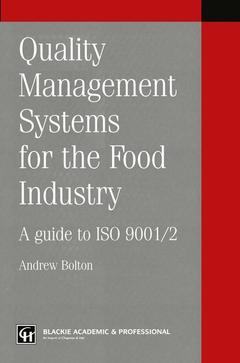Description
Quality management systems for the food industry, 1997
A guide to ISO 9001/2
Coordinator: Bolton Andrew
Language: English
Subjects for Quality management systems for the food industry:
Keywords
food; food industry; organization; quality assurance; quality management
Publication date: 03-2013
193 p. · 15.5x23.5 cm · Paperback
193 p. · 15.5x23.5 cm · Paperback
Description
/li>Contents
/li>Comment
/li>
Introduction. Quality management principles. Why ISO 9001 ? Preparation for the programme. Understanding the standard management responsibility. The quality system. Contract review : the relationship with customers. Purchasing : the relationship with suppliers. Internal process control. Internal quality audits. Training. mechanism of assessment. Achievement of the standard : what next ?
1 Introduction.- 2 Quality management principles — why BS EN ISO 9001?.- 3 Preparation for the programme — management commitment.- 4 Management responsibility.- 5 The quality system and document control.- 6 Buying and selling — purchasing and contract review.- 7 Design and development.- 8 Process control.- 9 Inspection, measuring and testing — calibration.- 10 Internal quality audit.- 11 Training.- 12 The assessment process.- 13 Achievement of the standard — what next?.- 14 Other accreditation/certification systems.- Appendix A Model quality manual: QFS Quality Food Services.- Appendix B Accredited third-party certification bodies.- Appendix C Guidance notes for the application of BS EN ISO 9001: 1994 for the food and drink industry.- Appendix D Guidance notes for the application of ISO 9002/EN29002/BS 5750: Part 2 To the hotel and catering industry.- Appendix E New Zealand Q-Base code: quality management systems for small and medium-sized enterprises — general requirements TB 004:1995.- Appendix F Glossary.- References.
The ISO 9001 series of standards accreditation (BS 5750) is of increasing importance to the food and drink industry. This book describes what the standards are and how to achieve them, and identifies both the potential benefits and limitations. It lists the approved bodies and the differences in their approaches and discusses the choice of accreditors, consultants and packages available for operating ISO 9001 systems. It also gives guidance on the basic format for a suitable quality system.
© 2024 LAVOISIER S.A.S.
These books may interest you

ISO 9001:2015 In Brief 223.58 €

ISO 9001:2015 In Brief 101.34 €

ISO 9001:2015 Audit Procedures 73.59 €

